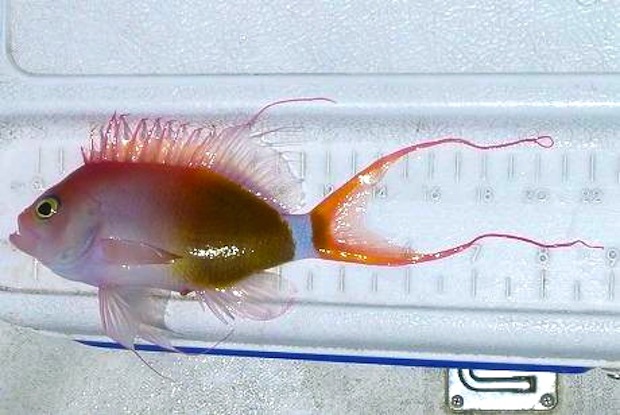There are some fish that are just so rare they’re almost mythical, and to see one would probably require divine intervention on some cosmic celestial level. We’re so fascinated with Odontanthias, and over the years few representatives from this genus have entered the trade, namely O. borbonius, O. fuscipinnis, O. katayamai, O. unimaculatus and O. chrysostictus (the last three are super rare deep water imports). The remaining members are only made available via fuzzy formalin stained dead pictures available on the internet.

Cue Odontanthias elizabethae. This is one species that has set itself apart from all the other preserved holotypes in the Odontanthias genus. There’s an aura of mystery that shrouds this species, from that brownish hue on its lower back, and that beautiful white sash on its caudal peduncle. As far as we know, it is endemic to the Hawaiian islands and surrounding locales, but because of its propensity for very deep water, no living specimens or pictures have ever been available.
Until now. Or rather, March 2013. This is not a recent thing, but not terribly long ago as well. It escaped our attention mainly because it was not documented in the most conventional of ways. The freshly caught (and dead) specimen headlining this article is the only picture we know that illustrates this species in fresh natural colour, and was caught by fishermen.
Big Island Fishing is a blog by japanese fishermen who, as the name of the site suggests, document their catch of the Hawaiian islands. This Hawaiian fishing diary is normally filled with pictures of mackerel and other food fish catches, but to the biggest surprise of us rare fish lovers, also includes a picture of the pseudo-legendary O. elizabethae. Fished up from bone crushing depths of 650ft, this fish is really quite unlikely to be pulled up alive anyway.
However it gives us a rare opportunity to observe this fish in its living (well almost) coloration, including that incredible incredible purple ribbon like tail filaments. Hopefully one day a living breathing swimming O. elizabethae will be documented, but until then this will have to do.




I believe I have a photo of an Odontanthias elizabethae. It was caught on 3/22/2025 during a deep sea fishing outing at around 600ft deep. The fish was alive and brought onboard the boat. After reading the article and doing some investigation online there are really no pictures of this fish I could locate other than the one in the article and ours. I would like to share the image with the world if it is in fact a Odontanthias elizabethae.